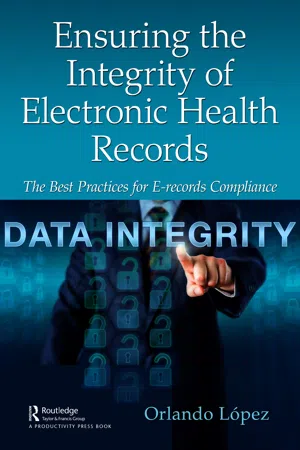
Ensuring the Integrity of Electronic Health Records
The Best Practices for E-records Compliance
- 320 pages
- English
- ePUB (mobile friendly)
- Available on iOS & Android
Ensuring the Integrity of Electronic Health Records
The Best Practices for E-records Compliance
About this book
Data integrity is a critical aspect to the design, implementation, and usage of any system which stores, processes, or retrieves data. The overall intent of any data integrity technique is the same: ensure data is recorded exactly as intended and, upon later retrieval, ensure the data is the same as it was when originally recorded. Any alternation to the data is then traced to the person who made the modification. The integrity of data in a patient's electronic health record is critical to ensuring the safety of the patient.
This book is relevant to production systems and quality control systems associated with the manufacture of pharmaceuticals and medical device products and updates the practical information to enable better understanding of the controls applicable to e-records. The book highlights the e-records suitability implementation and associated risk-assessed controls, and e-records handling. The book also provides updated regulatory standards from global regulatory organizations such as MHRA, Medicines and Healthcare Products Regulatory Agency (UK); FDA, Food and Drug Administration (US); National Medical Products Association (China); TGA, Therapeutic Goods Administration (Australia); SIMGP, Russia State Institute of Medicines and Good Practices; and the World Health Organization, to name a few.
Frequently asked questions
- Essential is ideal for learners and professionals who enjoy exploring a wide range of subjects. Access the Essential Library with 800,000+ trusted titles and best-sellers across business, personal growth, and the humanities. Includes unlimited reading time and Standard Read Aloud voice.
- Complete: Perfect for advanced learners and researchers needing full, unrestricted access. Unlock 1.4M+ books across hundreds of subjects, including academic and specialized titles. The Complete Plan also includes advanced features like Premium Read Aloud and Research Assistant.
Please note we cannot support devices running on iOS 13 and Android 7 or earlier. Learn more about using the app.
Information
Chapter 1
Introduction
- Health Canada Good Manufacturing Practices (GMP) Guidelines, Version 3 (GUI-0001), February 2018
- MHRA, GxP Data Integrity Guidance and Definitions, March 2018
- Russia Federal State Institute of Drugs and Good Practices (SIMGP), Data integrity and validation of computerized systems, August 2018
- PICS, Good Practices for Management and Integrity in Regulated GMP/GDP Environments (PI 041–1 (Draft 3)), November 2018
- US FDA, Data Integrity and Compliance with Drug CGMP. December 2018
- CEFIC, Practical risk-based guide for managing data integrity, March 2019
- WHO, Guideline on Data Integrity (Draft), October 2019
- US FDA and MHRA, Data Integrity in Global Clinical Trials, December 2019
- IPEC, Data Integrity for Pharmaceutical Grade Excipients, April 2020
- OECD, Advisory Document on GLP Data Integrity (Draft), August 2020
- NMPA (former CFDA), “Drug Data Management Practices Guidance,” December 2020
Table of contents
- Cover
- Half-Title
- Title
- Copyright
- Dedication
- Contents
- Foreword
- Preface
- 1 Introduction
- 2 E-records Lifecycle Revisited
- 3 Data and E-records Lifecycles – A Comparison
- 4 MHRA Guidance – Revisited
- 5 E-records Integrity Expectations of EU GMP Inspectors
- 6 Comparison of Health Authorities E-records Integrity Expectations
- 7 Maxims of E-records Integrity
- 8 Vulnerabilities of E-records
- 9 CGMP E-records Risk Management
- 10 CGMP E-records Risk Assessments
- 11 Security Service
- 12 Defining and Managing Manufacturing Data
- 13 Controls on Transient Data
- 14 Digital Date and Timestamps
- 15 E-records Migration and Its Integrity
- 16 Ensuring E-records Integrity of Cloud Service Providers
- 17 E-records Integrity in Hybrid Systems
- 18 Technologies Supporting E-records Integrity
- 19 Integration Between Computer Systems and E-records Lifecycles
- 20 Miscellaneous E-records Integrity Issues
- 21 E-records Remediation Project Revisited – Medicine Manufacturing
- 22 Designing E-records Integrity into your Practices
- 23 Introduction to Data Quality
- 24 Summary
- Appendix I: Glossary of Terms
- Appendix II: Abbreviations and/or Acronyms
- Appendix III: References
- Appendix IV: Things That Can Go Wrong when Validating Big Data Environments
- Appendix V: Data Integrity for Analytical Instruments connected to a LIMS
- Appendix VI: Data Integrity – EU Deviations
- Index